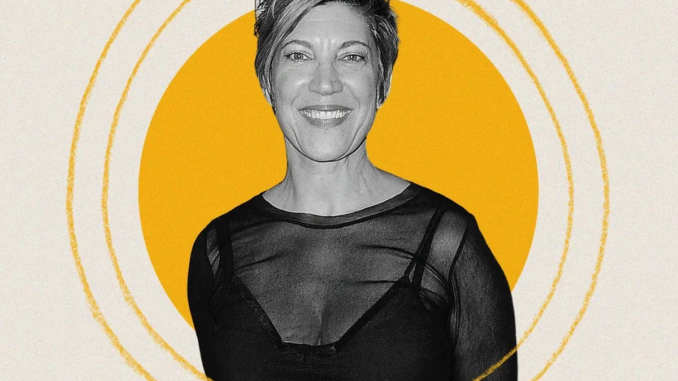
Introduction: The Emotional Weight of Directing a Grey’s Anatomy Episode
For over 18 seasons, Grey’s Anatomy has been known for its emotional storytelling, gut-wrenching moments, and unforgettable characters. But what many fans don’t realize is that behind each emotionally charged scene is a director who has to navigate the delicate balance of bringing those powerful stories to life. Allison Liddi-Brown, an accomplished director with several episodes under her belt, has become known for her ability to capture raw emotions and delve into the heart of the story.
One of Liddi-Brown’s most poignant episodes continues to resonate with fans and critics alike. In this interview, Liddi-Brown reflects on directing the deeply emotional “Grey’s Anatomy” episode that still lingers in the minds of fans, offering an inside look at the complexities of working on a show that often blurs the lines between life, death, and everything in between.
The Episode That Struck a Chord: What Made It So Special?
When asked about her most poignant episode of Grey’s Anatomy, Liddi-Brown immediately mentions one particular storyline that stood out for its emotional depth. “The beauty of Grey’s Anatomy lies in the way it allows us to explore universal human experiences: love, loss, hope, and fear,” she says. “One episode, in particular, focused on a life-changing decision that a character had to make under pressure. It was a culmination of everything the show does well: high-stakes moments, personal stakes, and of course, the medicine.”
Without giving too much away, Liddi-Brown reveals that this episode had all the hallmarks of Grey’s Anatomy’s signature style—the unexpected twists, the emotional breakthroughs, and the exploration of difficult choices. But it was the emotional journey of the character at the center of the storyline that made the episode stand out for her. “The way the actors embodied the pain, confusion, and hope of their characters… it was such a cathartic moment,” she recalls.
The Role of the Director in Crafting Such a Heartfelt Story
Directing an emotional episode like the one Liddi-Brown is describing requires a delicate touch. The balance between the script, actors’ performances, and the visual storytelling is key in making sure the emotions come through authentically. Liddi-Brown describes how she worked closely with the actors to make sure the story’s emotional beats landed in a way that felt real.
“It’s all about creating a space where the actors feel like they can bring their full selves to the performance,” Liddi-Brown explains. “We did a lot of preparation, a lot of conversation about emotional vulnerability. For me, it’s important to let the actors find their moments without pushing too hard. The more organic the reactions, the more powerful the scene will be.”
One of the most impactful moments of the episode, according to Liddi-Brown, was when a character had to make a life-or-death decision that would affect not only their future but the future of those they loved. It was a moment of intense moral conflict and emotional vulnerability. The stakes were high, and the tension between hope and fear was palpable.

The Power of Silence in Storytelling
A key technique Liddi-Brown often employs to intensify emotional moments is the strategic use of silence. She explains, “Sometimes, the most poignant moments don’t need words. Silence allows the emotions to speak louder than any dialogue. It’s about letting the viewer feel the weight of the situation, not just understand it intellectually.”
This technique can be especially effective in an episode like the one Liddi-Brown directed, where the characters were facing life-changing decisions. Rather than relying on dramatic speeches or over-the-top emotions, Liddi-Brown leaned into the quiet intensity of the characters’ internal struggles.
“When there’s so much at stake, sometimes all you need is a quiet moment where a character’s thoughts and feelings are evident in their expressions or in the way they look at another person. That’s where the real drama lies,” she explains.
The Challenge of Balancing the Medical Drama with Personal Stories
One of the trademarks of Grey’s Anatomy is how it expertly blends medical drama with personal stories, often putting the characters’ professional lives on a collision course with their personal dilemmas. For Liddi-Brown, this dual focus can be both a challenge and a gift. “The medical aspect provides such a clear framework for the story, but the personal stakes are where the real emotion comes from,” she explains.
In the episode she directed, there was a perfect balance between the medical crisis and the personal journey the character was undergoing. The life-or-death situation in the operating room mirrored the emotional turmoil happening off-screen, creating a seamless blend of high-stakes medicine and heartfelt human conflict.
Liddi-Brown notes that the key to directing these types of episodes is pacing. “You have to build the tension slowly. The viewers need time to invest in the characters, to understand the stakes. Only then can the payoff come when everything feels like it’s on the line.”
The Cast’s Commitment to Emotional Authenticity
One of the standout features of Grey’s Anatomy is the incredible performances from the cast, who consistently bring their characters to life in deeply authentic ways. For Liddi-Brown, directing a poignant episode is made all the more rewarding because of the commitment and emotional investment from the cast. “I am in awe of how the actors bring these characters to life,” she says. “They give so much of themselves in every scene, and that makes my job easier because I can trust them to carry the weight of the story.”
Liddi-Brown recounts working closely with Ellen Pompeo (Meredith Grey), Chandra Wilson (Bailey), and James Pickens Jr. (Richard Webber) during key emotional moments. “Ellen, in particular, is incredibly intuitive when it comes to understanding the emotional through-line of the story. She knows exactly when to hold back and when to let her emotions flood the scene,” Liddi-Brown observes. “With Chandra, there’s this grounded authenticity she brings to every moment. And James, as Richard Webber, has such a natural gravitas—you don’t need to ask much from him because he just brings it.”
The Legacy of ‘Grey’s Anatomy’ and Its Enduring Impact
As Grey’s Anatomy continues to evolve and introduce new characters and storylines, Liddi-Brown reflects on the lasting impact the show has had on both audiences and the entertainment industry. “It’s an honor to be part of a show that has touched so many lives,” she says. “We explore difficult topics—love, loss, the fragility of life—and we do it in a way that resonates with people in a meaningful way.”
For Liddi-Brown, directing an episode of Grey’s Anatomy is not just about the craft—it’s about the human experience. “When I step behind the camera, I am always thinking about the humanity of the story. It’s not just about making a pretty shot; it’s about telling a story that can make someone feel something deep inside them.”
Conclusion: A Director’s Touch to the Heart of ‘Grey’s Anatomy’
Allison Liddi-Brown’s work on Grey’s Anatomy stands as a testament to her ability to bring out the raw emotions of the characters and craft stories that resonate with viewers. Through her meticulous direction, Liddi-Brown has managed to create episodes that don’t just entertain but move people in a way that few TV shows can. Her approach to emotional storytelling, blending silence with dialogue and mixing medical drama with personal conflict, ensures that the emotional heart of the show remains strong.
For fans of Grey’s Anatomy, Liddi-Brown’s poignant episode will always stand as a highlight in the show’s storied history—proof that sometimes, the best stories are the ones that don’t need to be told with words, but with the unspoken emotions that speak louder than any dialogue ever could.
FAQs
1. How long has Allison Liddi-Brown been directing on ‘Grey’s Anatomy’?
Allison Liddi-Brown has been directing episodes of Grey’s Anatomy since Season 6, with several poignant and memorable episodes under her belt.
2. What makes Allison Liddi-Brown’s directing style unique?
Liddi-Brown is known for her ability to balance emotionally charged moments with subtle storytelling, often using silence and visual cues to enhance the impact of the narrative.
3. What episode did Allison Liddi-Brown direct that fans consider particularly emotional?
One of Liddi-Brown’s most poignant episodes focused on a life-or-death decision involving one of the main characters, capturing the emotional stakes in a powerful and moving way.
4. Does Liddi-Brown work closely with the cast during emotional scenes?
Yes, Liddi-Brown places a strong emphasis on collaborating with the cast to ensure that the emotional authenticity of the scenes comes through. She trusts the actors to bring their best performances to the table.
5. How does Allison Liddi-Brown feel about the impact of ‘Grey’s Anatomy’?
Liddi-Brown views her work on Grey’s Anatomy as an opportunity to tell deeply human stories, and she feels honored to contribute to a show that has had such a lasting impact on audiences worldwide.
